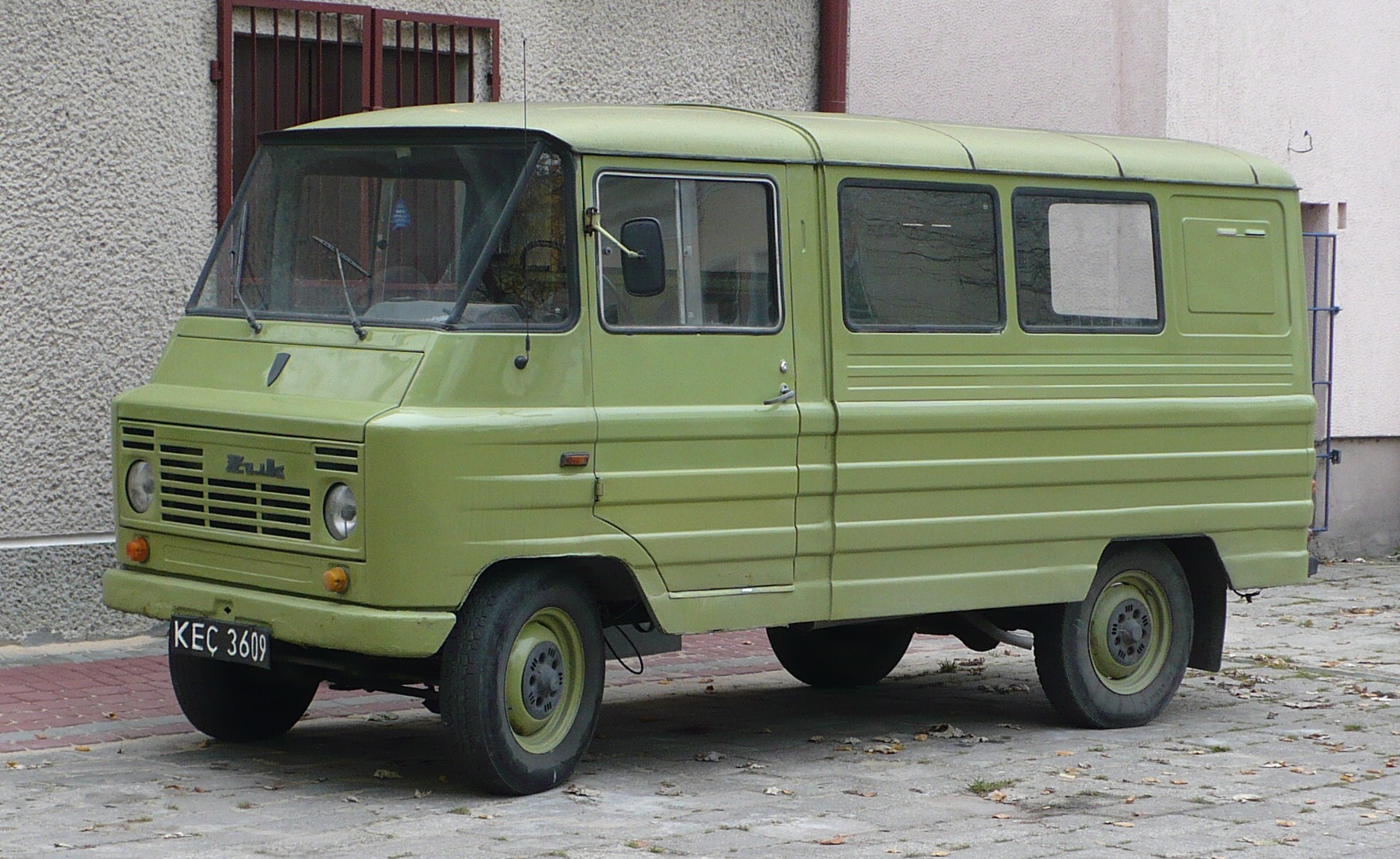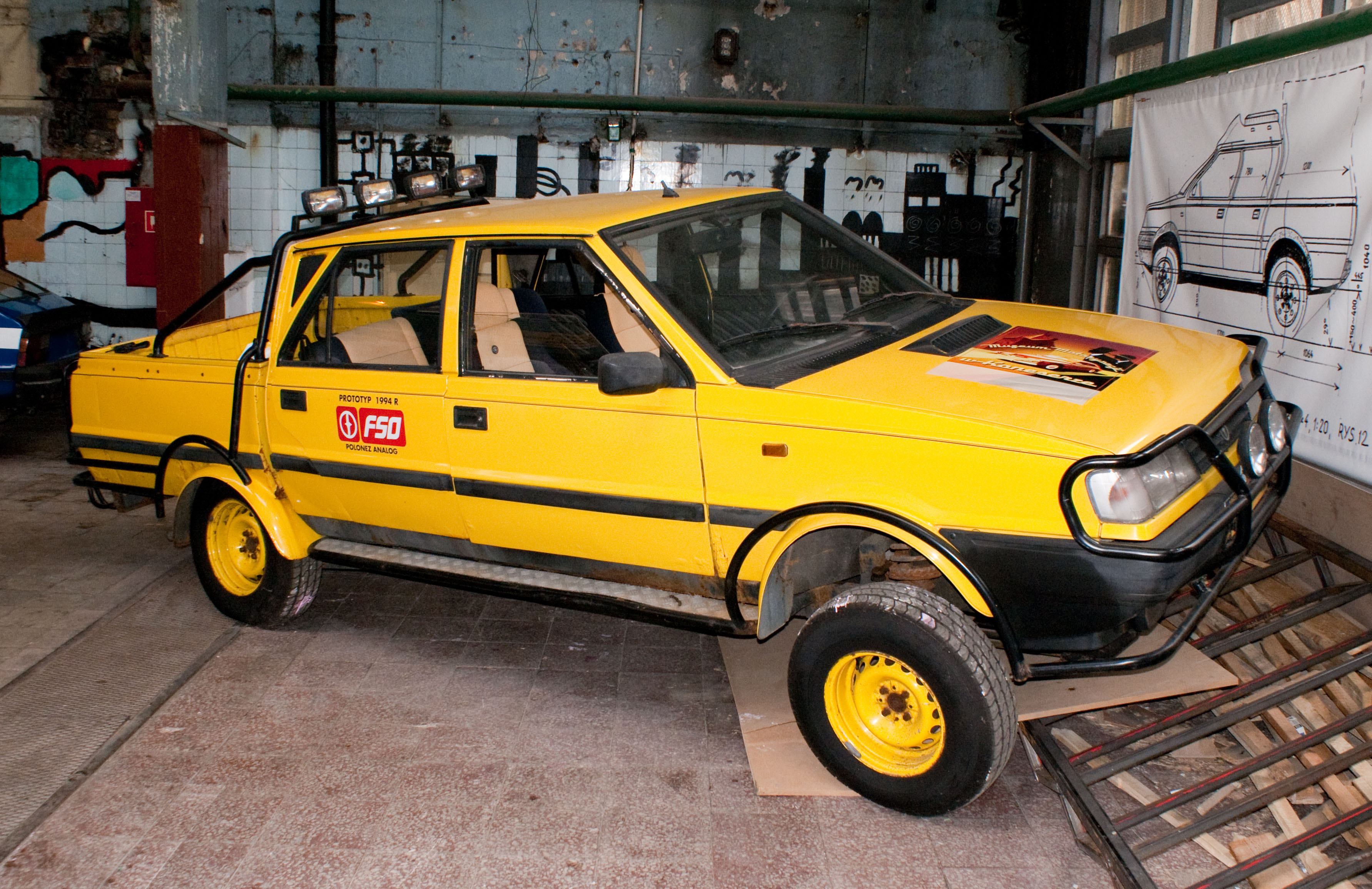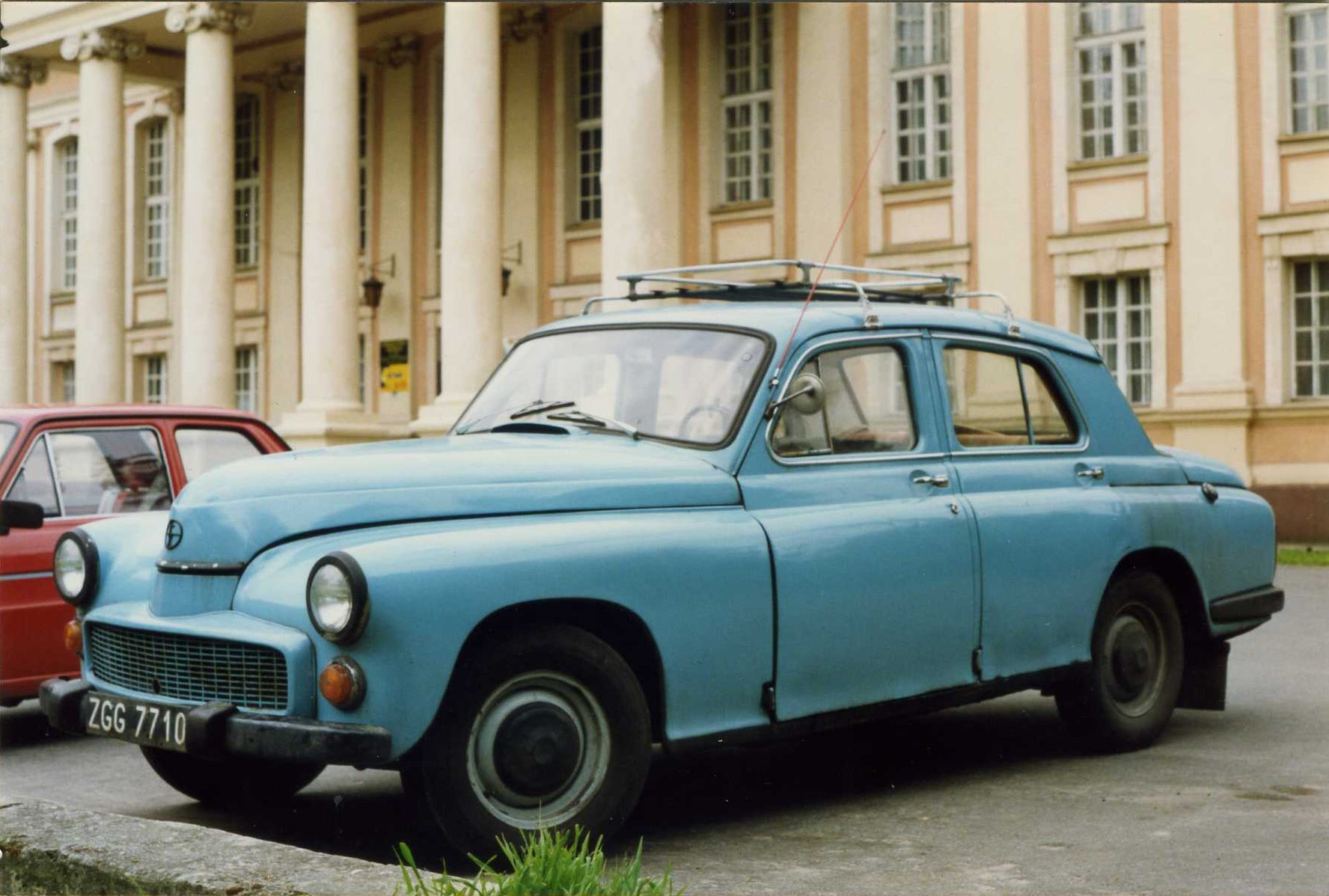|
Tarpan Honker
Honker (initially known as Tarpan Honker, also Daewoo Honker, Andoria Honker, Intrall Honker 4x4, and DZT Tymińscy Honker) is a Polish multi-purpose off-road vehicle. Shown as a prototype in 1984, it was produced in a variety of models. It is best known for its use by the Polish Army both at home and in Iraq. Apart from the army and police forces, the company to own the largest number of Honkers is the Polish KGHM company, which uses them to transport miners underground. History The prototype of the Honker was created in 1984 in the Fabryka Samochodów Rolniczyc(Farming Vehicles Works) or FSR in Poznań. Based on the earlier design of the Tarpan, it was to replace it as the basic Polish-made light commercial off-road vehicle in public services, a role previously held by both its predecessor and the imported Soviet UAZ-469. However, it was not until 1988 that serial production was started. The car was produced in two variants: *Tarpan Honker 4012, a typical hardtop with room fo ... [...More Info...] [...Related Items...] OR: [Wikipedia] [Google] [Baidu] |
Fabryka Samochodów Ciężarowych
The FSC Lublin Automotive Factory ( pl, Fabryka Samochodów Ciężarowych) commonly known as FSC, is a large motor vehicle factory in Poland established while the country was part of the Soviet Bloc. It was founded in 1950. The first vehicle left its assembly line on November 7, 1951. The factory was built on an open field in Lublin from the grounds up, to first produce light trucks and later vans, as well as vehicles for the military. History After the 1989 collapse of the communist system in Poland, and the establishment of a free market economy, the state-owned FSC factory began to establish links with companies outside Poland. In 1995 the factory entered a joint venture with the South Korean conglomerate Daewoo. It soon become a part of the new company Daewoo Motor Polska. In December 1995 the factory started assembling Daewoo Nexia passenger cars. Around 40,000 were produced before production ended in 1998. Daewoo also began a joint project with British manufacturer LDV ... [...More Info...] [...Related Items...] OR: [Wikipedia] [Google] [Baidu] |
Two-wheel Drive
Two-wheel-drive (2WD) denotes vehicles with a drivetrain that allows two wheels to be driven, and receive power and torque from the engine, simultaneously. Four-wheeled vehicles For four-wheeled vehicles (and by extension, vehicles with six, eight, or more wheels), this term is used to describe vehicles that are able to power at most two wheels, referred to as either front, or rear-wheel-drive. The term 4x2 is also used, to denote four total wheels with two being driven. Most road vehicles use a 2WD layout due to its lightweight and simplicity. Traction on the road is usually sufficient that the driving force can be reliably transmitted through only two wheels. For vehicles that have part-time four-wheel drive, the term refers to the mode when 4WD is deactivated and power is applied to only two wheels. Two-wheeled vehicles For two-wheeled vehicles such as motorcycles and bicycles, the term is used to describe vehicles that can power the front as well as the back wheel. T ... [...More Info...] [...Related Items...] OR: [Wikipedia] [Google] [Baidu] |
Military Of Latvia
The Latvian National Armed Forces ( lv, Latvijas Nacionālie bruņotie spēki), or NBS, are the armed forces of Latvia. Latvia's defense concept is based on a mobile professional rapid response force and reserve segment that can be called upon relatively fast for mobilization should the need arise. The National Armed Forces consists of Land Forces, Naval Forces, Air Force and National Guard. Its main tasks are to protect the territory of the State; participate in international military operations; and to prevent threats to national security. Mission The mission of the National Armed Forces (NAF) is to defend the sovereignty and territorial integrity of the nation and to defend its population against foreign or domestic armed aggression. In order to implement these tasks, the NAF provide for the defence of the nation, its air space and national territorial waters, participate in large scale crisis response operations, perform emergency rescue operations, and participate in interna ... [...More Info...] [...Related Items...] OR: [Wikipedia] [Google] [Baidu] |
Iraqi Army
The Iraqi Ground Forces (Arabic: القوات البرية العراقية), or the Iraqi Army (Arabic: الجيش العراقي), is the ground force component of the Iraqi Armed Forces. It was known as the Royal Iraqi Army up until the coup of July 1958. The Iraqi Army in its modern form was first created by the United Kingdom during the inter-war period of ''de facto'' British control of Mandatory Iraq. Following the invasion of Iraq by U.S. forces in 2003, the Iraqi Army was rebuilt along U.S. lines with enormous amounts of U.S. military assistance at every level. Because of the Iraqi insurgency that began shortly after the invasion, the Iraqi Army was later designed to initially be a counter-insurgency force. With the withdrawal of U.S. troops in 2010, Iraqi forces have assumed full responsibility for their own security. A ''New York Times'' article suggested that, between 2004 and 2014, the U.S. had provided the Iraqi Army with $25 billion in training and equipment in ... [...More Info...] [...Related Items...] OR: [Wikipedia] [Google] [Baidu] |
Tarpan Honker World Operators
The term tarpan (''Equus ferus ferus'') refers to free-ranging horses of the Russian steppe from the 18th to the 20th century. It is generally unknown whether those horses represented genuine wild horses, feral domestic horses or hybrids. The last individual believed to be a tarpan died in captivity in the Russian Empire during 1909. Beginning in the 1930s, several attempts were made to develop horses that looked like tarpans through selective breeding, called "breeding back" by advocates. The breeds that resulted included the Heck horse, the , and a derivation of the Konik breed, all of which have a primitive appearance, particularly in having the grullo coat colour. Some of these horses are now commercially promoted as "tarpans", although such animals are only domestic breeds and not the wild animal themselves. Name and etymology The name "tarpan" or "tarpani" derives from a Turkic language ( Kazakh or Kyrgyz) name meaning "wild horse". The Tatars and the Cossacks distinguis ... [...More Info...] [...Related Items...] OR: [Wikipedia] [Google] [Baidu] |
Iveco Daily
The Iveco Daily is a large light commercial van produced by the Italian automaker Iveco since 1978; it was also sold as the Fiat Daily by Fiat until 1983. Unlike the more car-like unibody Fiat Ducato, the Daily uses a separate ladder frame typical of heavier commercial vehicles. The Iveco Daily is produced at the Iveco Suzzara plant, near Mantova in Italy, where Iveco has recently made substantial investments to renew the production lines. The Daily is also the longest-running vehicle of the Iveco production and in over 40 years have sold over three million units. Today it is marketed in 110 markets around the world. First generation (1978) Fiat Daily (1978) In 1978, Fiat presented a revolutionary vehicle called Daily. Light utility, succeeding the old Fiat 242 and Fiat 616N, it immediately received a very favorable reception from users, who appreciated its excellent qualities of robustness and versatility. Its transformations for specific uses are numerous: panel van, chas ... [...More Info...] [...Related Items...] OR: [Wikipedia] [Google] [Baidu] |
Renault Master
The Renault Master is a large van produced by the French manufacturer Renault since 1980, now in its third generation. It replaced the earlier Renault Super Goélette light trucks. Opel has sold versions of the second and third series vans as the Opel Movano in Continental Europe and Vauxhall Movano in the United Kingdom. All three generations have been designed and manufactured by Renault, irrespective of the brand. Over its lifetime, several different body styles have been available, from the standard van to bigger models with an increased load area, height, and longer wheelbases with an LWB prefix. Panel vans are very common, but pickups are also available. Heavier duty models of the Master were also sold by (now Volvo owned) Renault Trucks as the B series, later as the Messenger and the Mascott. __TOC__ First generation (1980) The original Renault Master was launched in September 1980. Originally launched with the Fiat-Sofim diesel engine, and from 1984 als ... [...More Info...] [...Related Items...] OR: [Wikipedia] [Google] [Baidu] |
Iveco
IVECO, an acronym for Industrial Vehicles Corporation, is an Italian multinational transport vehicle manufacturing company. It designs and builds light, medium, and heavy commercial vehicles. The name IVECO first appeared in 1975 after a merger of Italian, French, and German brands. Its production plants are in Europe, China, Russia, Australia and Latin America and it has about 5,000 sales and service outlets in over 160 countries. The worldwide output of the company amounts to around 150,000 commercial vehicles with a turnover of about 10 billion. The company was spun-off from CNH Industrial on 1 January 2022. It is subsidiary of Iveco Group N.V., a holding company incorporated in Amsterdam, Netherlands, and is listed on Borsa Italiana. History IVECO was incorporated on 1 January 1975, with the merger of five different brands: FIAT Veicoli Industriali (with headquarters in Turin), OM (Brescia, Italy), Lancia Veicoli Speciali (Italy), Unic (France), and Magirus-Deutz (Germ ... [...More Info...] [...Related Items...] OR: [Wikipedia] [Google] [Baidu] |
FSO Polonez
The FSO Polonez is a motor vehicle that was developed in Poland in collaboration with Fiat and produced by Fabryka Samochodów Osobowych from 1978 to 2002. It was based on the Polski Fiat 125p platform with a new hatchback design by Giorgetto Giugiaro. It was available in a variety of body styles that included two- and four-door compact-sized cars, station wagons, as well as commercial versions that included pickup truck, cargo van, and ambulance versions. Production totaled more than one million units excluding the pickup truck and van variants. The Polonez was marketed in other nations and was popular in its domestic market until Poland joined the European Union in 2004. The car's name comes from the Polish dance, the polonaise, and was chosen through a readers' poll conducted by the newspaper ''Życie Warszawy''. In 2021, about 33,000 vehicles were still registered in Poland. Background The Polonez was based on the Polski Fiat 125p that Fabryka Samochodów Osobowych (FSO) ... [...More Info...] [...Related Items...] OR: [Wikipedia] [Google] [Baidu] |
ZSD Nysa
The Nysa van was produced in the town of Nysa, Poland, from 1958 until 1994. The Nysa was based on the same chassis as the angular shaped Żuk van, but had rounded body lines, especially the two-part rounded windshield, and was considered more comfortable and a better fit for carrying people. The basic body variant was a universal van, for cargo or persons, with sliding doors on the right or conventional doors (marked with a letter T - ). At the rear, most variants had a single door opening to the left side. A few variants existed: a cargo van (letter F - ), a minibus (letter M) and an ambulance (letter S), and some others. A rare variant was made in the form of a light truck. At the time, the Nysa was practically the only van-size ambulance used in Poland. Many vans were sold to the Militia, which was the only form of police during the Communist era in Poland; blue Nysa vans became a kind of "trademark" of the Militia (Militia variants had slide doors on both sides, most had als ... [...More Info...] [...Related Items...] OR: [Wikipedia] [Google] [Baidu] |
FSC Żuk
The Żuk ( pl. ''beetle'') was a van and light truck produced in Lublin, Poland, between 1958 and 1998 by FSC. It was based on FSO Warszawa, which in turn was licensed from the Soviet passenger car GAZ-M20 Pobeda. The chassis, suspension and engine from FSO Warszawa formed the basis of the Żuk and the Nysa light vans designed in the late 1950s. About were manufactured. The Żuk was mainly sold to state organizations, but also to individuals. After 1989, with the liberalization of the Polish economy, the Żuk was able to maintain sales to the traditional markets and expand the number sold to individual consumers. The final few years of production was in parallel to its successor, the Lublin van, as a cheaper alternative. The Żuk came in a range of body styles. The most common were van and light 1.1-ton pickup truck. Rarer variants were minibus and a long-cab truck. Rare for a van, it had independent front suspension. It was very angular, with a number of wide channels run ... [...More Info...] [...Related Items...] OR: [Wikipedia] [Google] [Baidu] |
FSO Warszawa
:''Sections of this article are translated from Polish Wikipedia''. FSO Warszawa (from Polish: '' Warsaw'') was an automobile manufactured in FSO factory in Warsaw, Poland between 1951–1973, based on GAZ-M20 Pobeda. The Warszawa was the first newly designed car built in Poland after the World War II. Warszawas were popular as taxis because of their sturdiness and ruggedness. However, they were underpowered for their weight and had high fuel consumption. In total, 254,471 cars were made. Description Original M20 model Named after the city of Warsaw, the Warszawa was until 1957 identical to the Soviet Pobeda, built under license, which was given to Poland by GAZ at Joseph Stalin's insistence. Exports of the car started in 1954 to countries such as Romania, China, Bulgaria and Albania. In 1956 work began on the development of a new four-speed gearbox. However, it failed in practice and its development was suspended. In the same year, work began on an overhead valve eng ... [...More Info...] [...Related Items...] OR: [Wikipedia] [Google] [Baidu] |





